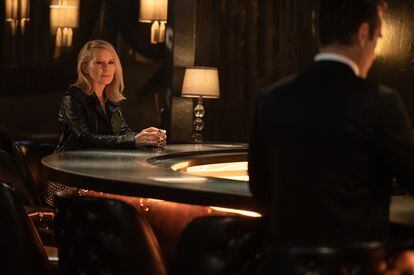When the viewer meets John Sugar, it is in black and white. He is in Tokyo and is looking for the son of a boss of the Yakuza, the dangerous Japanese mafia. Shortly after, with that case already solved, in color and accompanied by the protagonist's own voice-over, John Sugar will accept a new case. Very discreet, very effective and specialized in the search for missing people, he now hires a legendary Hollywood producer to search for his granddaughter.
Sugar (premiere on April 5 on Apple TV+ with its first two episodes) is, without disguise, a love letter to the classic literary and cinematographic genre of private detectives. It is in his character, the kind of lonely, tormented, mysterious man of few words that Humphrey Bogart or Robert Mitchum could have played and played here by Colin Farrell. It is in its aesthetics and in the movements and angles of the camera, inspired by the cinema of the forties and fifties. And the clips of classics like Return to the past (1947), Story of a detective (1944), The eternal dream (1946), The maltese falcon (1941), The deadly kiss (1955) or The bribed (1953) that interrupt the flow of the chapters.
And above all, there is chinatown (1974), the film that Simon Kinberg, one of the executive producers of Sugar, mentioned as a clear reference for the series created by Mark Protosevich and directed by the Brazilian Fernando Meirelles. “Although the DNA and genetics of the not to go “It's in a lot of what we see today and in the detective series that are on television, and God knows there are hundreds, and in many crime movies, I wanted to do something that was a love letter to those original movies.” says the producer in a video call interview. “Now, either there are detective and police stories, where the important thing is the plot, or they turn to something more interesting, for me, which is the characters and the emotion. The combination of the two things is rare to find today. “As someone who has been in this for a long time, I think now you don't have that combination of a story with depth and great character work at the same time,” he adds.
Sugar, in addition to paying homage to him, updates the noir genre and the stereotype of the private detective. “In the movies not to go Classics, the detective tends to be someone trustworthy, capable and not particularly mysterious, a bit one-dimensional. Sugar's character is, in many ways, the series' biggest mystery. He is complex, vulnerable and human,” Kinberg explains. This was helped by the contributions of Colin Farrell. The Irish actor, also executive producer of this fiction, helped build the character and give personality to the entire production, as Kinberg explains. “He has brought to the character the strength and charisma of a movie star, and at the same time, you feel that he is a wounded, broken and vulnerable, innocent man,” adds the producer, who also highlights the strength of female characters such as another element in which the series differs from not to go more classic, where women tended to be “either weak or evil.” In addition, the plot of the series, set in the present, addresses topics such as addiction, misogyny, sexual and racial identity, sexual harassment and human trafficking.
The love letter he writes Sugar, with eight chapters that, with the exception of the first, barely exceed half an hour, has more audiences. Another of them is cinema in general. Many of the locations contain references to classic Hollywood. For example, the large mansion in which the veteran producer who hires Sugar, Jonathan Siegel (played by James Cromwell), lives was the residence of the producer of James Bond Albert Broccoli. The bar where Sugar meets Melanie, the stepmother of the girl he's looking for (played by Amy Ryan), is actually the legendary Boardner'sa pub that opened its doors in 1927 and that, among many others, has appeared in LA Confidential (1997).

The third recipient of this letter is, precisely, the city of Los Angeles. Like titles like A long goodbye, Chinatown, Heat or, of course, LA Confidential, Sugar also explores a city that, in the words of Simon Kinberg, is “a fascinating, complex and chaotic place.” “I live here and it is a place of incredible darkness, incredible light, goodness, evil, corruption, kindness… That's why I think chinatown It was a great reference for us, because it shows the highest points of Los Angeles and Hollywood, what everyone fantasizes about, and then also the reality of that fantasy, which can be very dark, very cruel, very violent and dangerous. ”, he reflects.
Recording in Los Angeles was also, at the same time, the biggest challenge for the production. “It's very unusual to film in Los Angeles, even though people in the industry live here. I've been in this business for about 25 years and I've only done one other thing here before, and it was my first movie, Mr and Mrs smith. It is very difficult to cut a street in a city where everyone drives. Working on locations here is harder than it should be.”
For Kinberg, also creator of the Apple TV+ series Invasion, detective stories allow us to bring order and peace of mind in the current chaos. “Our world is scary and chaotic, it's complicated, and the truth is hard to find because social media and new media and even our leaders lie to us. The idea of the detective as a beacon of truth, someone who can find the truth, in a world where everything is so confusing, it is comforting, and perhaps now more than ever because the world is more chaotic than ever.”
You can follow EL PAÍS Television on x or sign up here to receive our weekly newsletter.
#39Sugar39 #writes #love #letter #39noir39 #Hollywood #Los #Angeles